Sinking of ARA Admiral Belgrano - 2nd May 1982 
ARA General Belgrano seen refueling at the Ushuaia on the southern tip of Argentina, April 1982
Argentina invaded the Falkland Islands on 2nd April 1982. One month later, on the 2nd May, the British submarine HMS Conqueror sank the Argentinian cruiser ARA Admiral Belgrano. It was the first and only sinking of a warship during wartime by a nuclear-powered submarine.
Background
In response to the invasion the British dispatched a Taskforce to recapture them under the codename Operation CORPORATE. Visibly the taskforce consisted of warships and troopships. Invisibly it included five nuclear powered attack submarines (SSNs) and one diesel-electric submarine (SS) for special operations.
Being faster than the surface ships the SSNs arrived in theatre first (they travelled at around -28-29 Knots constant). In fact, two set sail before the actual Argentinian landings. The five SSNs were;
- HMS Splendid, a Swiftsure Class SSN, set sail 1st April commanded by Cdr. Roger Lane-Nott
- HMS Spartan, a Swiftsure Class SSN, set sail 1st April commanded by Cdr. James Taylor
- HMS Conqueror, a Churchill Class SSN, set sail 4th April commanded by Cdr. Chris Wrenford-Brown
- HMS Valiant, a Valiant Class SSN, set sail 2nd May commanded by Cdr. Tom Le Marchant
- HMS Courageous, a Churchill Class SSN, set sail 12th May commanded by Cdr. Rupert Best
Initially the plan involved using the SSNs to get Special Forces (SBS and SAS) to the Falklands as fast as possible, and 6 SBS joined HMS Conqueror at Faslane before she set off. This involved loading about 6 tons of equipment (weapons, ammunition, explosives, inflatable boats, breathing apparatus, canoes and possibly diver propulsion devices) into the torpedo room the already heavily laden submarine. 2 SBS flew ahead to Ascension Island which was about half way between Britain and the Falklands where they would join either HMS Spartan or HMS Splendid.

The use of SSNs to land Special Forces was not popular in some sections of the Submarine Service and naval planners as it detracted from the submarines’ primary missions of sinking enemy ships and ISR (Intelligence Surveillance and Reconnaissance). Soon plans were changed and 6 SBS were cross-decked to surface combatants, and 2 SBS plus the SAS (and later 3 SBS) instead travelled south on surface ships. This did delay their arrival but freed up the SSNs to hunt for the Argentinian Navy. Meanwhile a single diesel-electric submarine, HMS Onyx (S-21), was sent south to support Special Operations.
The SSNs were already Cold War warriors used to real operations in dangerous waters (for example, HMS Splendid was trailing a Soviet VICTOR Class SSN at the moment she was ordered to ‘Store for War’ and head south to the Falklands). But this was their first actual shooting war. On the 12th April, just 10 days after the Argentinian landings, the first SSN HMS Spartan arrived in the Exclusion Zone declared around the Falkland islands.
The Argentinian surface fleet that Belgrano was part of was considered a good match for the British Taskforce, having a potent aircraft carrier (ARA Veinticinco de Mayo (V-2)) and more Exocet equipped warships. The main weakness (according to an Argentinian account) was their poor defense against British nuclear powered submarines. It was considered that the British submarines could detect the Argentinian warships from greater ranges and launch torpedo attacks from outside the detection range. This was only partly true (see the torpedo used, below), but there is no doubt that the fast and well trained British submarines had a massive advantage.
Argentina had three submarines but one was in dry dock, leaving just one World War Two vintage ex-US Navy fleet boat (ARA Santa Fe (S-21)) and a more potent German supplied Type-209 diesel-electric submarine ARA San Luis (S-32). ARA Santa Fe had played a crucial role during the Argentinean invasion of the islands by landing Special Forces from the Navy’s Buzos Tacticos to mark the beach. However she was caught on the surface by British helicopters during the retaking of South Georgia on 25th April.
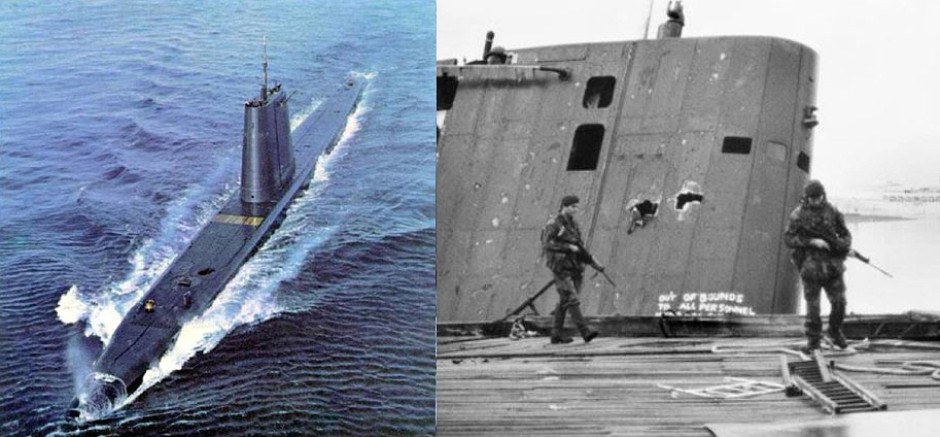
ARA Sante Fe before and after capture by British forces
ARA San Luis got closer to being successful and is reported to have launched two torpedo attacks, one on 1st May against British frigates and the second on 10th May, also against a frigate. Both attacks were unsuccessful.
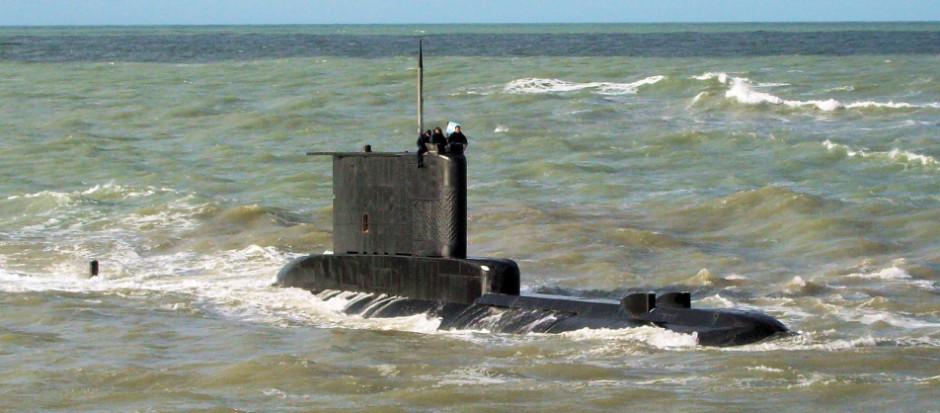
Argentinian Navy Type-209 submarine
THE book on Special Forces subs Covert Shores 2nd Edition. A world history of naval Special Forces, their missions and their specialist vehicles. SEALs, SBS, COMSUBIN, Sh-13, Spetsnaz, Kampfschwimmers, Commando Hubert, 4RR and many more.
Check it out on Amazon
ARA Admiral Belgrano 
ARA Admiral Belgrano was a Brooklyn-class light cruiser which had been commissioned as USS Phoenix (CL-46) in 1938. After World War Two she was sold to Argentina (1951) and had been modestly upgraded with British supplied Seacat SAMs in the late 1960s. Rumors that she was also fitted with French supplied MM38 Exocet anti-ship missiles are incorrect.
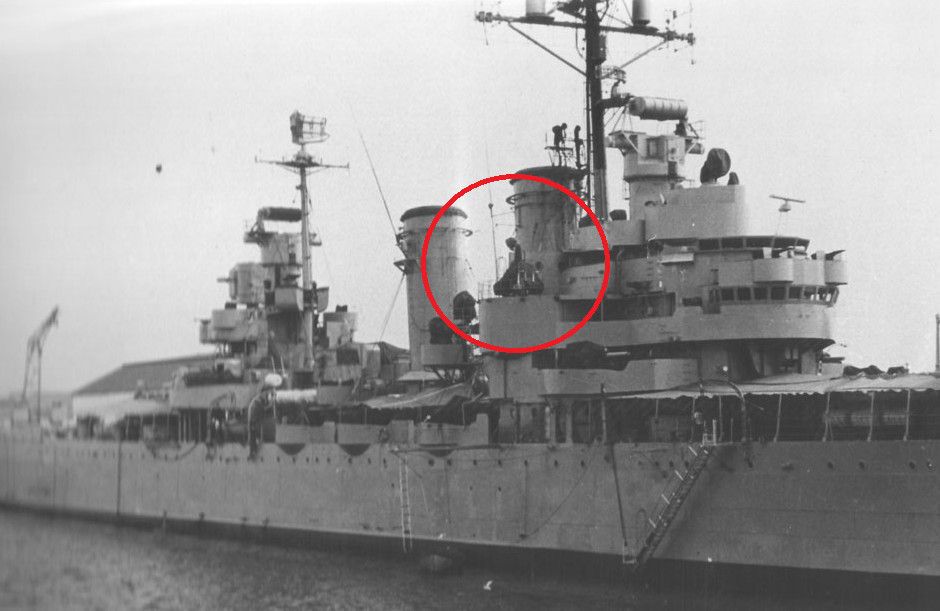
ARA Admiral Belgrano with Seacat SAM system circled.
Specifications
Displacement: greater than 14,700 tonnes surfaced (est. 17,000 tonnes), 24,000 tonnes submerged (estimated 30,0000 tonnes)
Displacement: 9,575 tons (empty) 12,242 (full load)
Length: 608.3 ft (185.4 m)
Beam: 61.8 ft (18.8 m)
Draft: 19.5 ft (5.9 m)
Speed: 32.5 knots (60.2 km/h; 37.4 mph)
Complement: 1,138 officers and men
Armament: 15 × 6"/47 cal (152 mm) guns, 2 x Sea Cat air defense missile systems, 8 × 5"/25 cal (127 mm) dual-purpose guns, 40 mm and 20 mm anti-aircraft autocannons
Armor: Main Belt: 5.5" (140 mm), Deck: 2" (50 mm), Barbettes: 6" (152 mm), Turret Roofs: 2" (50 mm), Turret Sides: 6.5" (170 mm), Conning Tower: 5" (127 mm)
Helicopters: 2 Aérospatiale Alouette-III
Although old, it was not unusual for the once-grand South American navies to operate WW2 cruisers in the early 1980s:
- Chile - Former USS Brooklyn (CL-40) renamed O’Higgins (CL-2) and former USS Nashville (CL-43) renamed Captain Pratt (CL-01) and former HSwMS Göta Lejon renamed Almirante Latorre (CL-04)
- Peru - Former HNLMS De Ruyter (C801) renamed BAP Almirante Grau (CLM-81) and former HNLMS De Zeven Provinciën renamed BAP Aguirre (CH-84)
Belgrano’s sistership, ARA Nueve de Julio (C-5), had only been decommissioned and scrapped two years earlier. ARA Admiral Belgrano had been in refit when the invasion happened but was ready to sail south in time for the British Taskforce’s arrival.
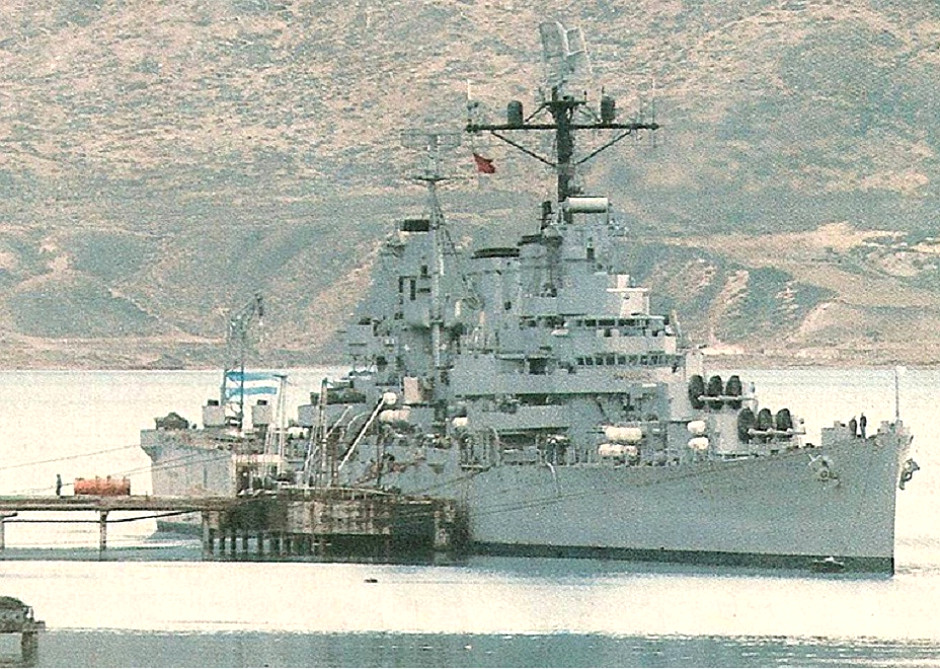
ARA General Belgrano seen refueling at the Ushuaia on the southern tip of Argentina, April 1982
HMS Conqueror 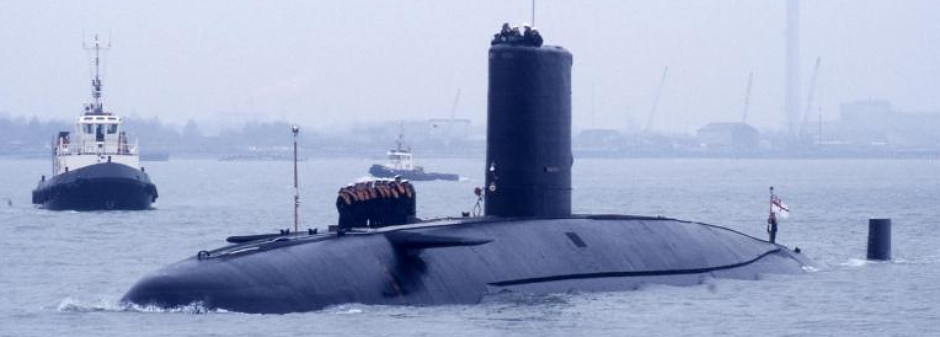
HMS Conqueror was a Churchill Class SSN which had joined the Royal Navy in 1971. In evolutionary terms the Churchill Class were roughly equivalent of the US Navy’s Permit Class although they were more recent. They were much quieter than the first generation of SSNs but not as quiet as the latest classes (Swiftsure Class in UK and Los Angeles Class in US). They were however faster than these later boats, and still far more capable than anything Argentina could field.
Before Operation CORPORATE, HMS Conqueror had been involved in Cold War covert operations near the Kola Peninsula in USSR. In particular HMS Conqueror had been slated to perform a daring raid on Soviet towed sonar arrays in which an operational array would be ripped from a WarPac ship – Operation BARMAID. Towed sonar arrays were a strategic technology and NATO had enjoyed a strong lead during the 1970s, but the Soviets had recently started fielding similar devices and it was suspected that espionage was involved. The plan was that Conqueror would creep up on a WarPac vessel which had a towed array deployed, and using specifically designed cutting gear, steal it. The cut would be made in such a way that it would look like the cable had snapped. Using a submarine to steal a state-of-the-art anti-submarine detection system was certainly bold.
The Falklands war temporarily interrupted Operation BARMAID but Conqueror returned to the task after the war and was successful! An incredible feat which might arguably be even more significant than the sinking of the Belgrano.
Specifications
Displacement: 4,900 tonnes (submerged)
Length: 86.9 m (285 ft)
Beam: 10.1 m (33 ft)
Draught: 8.2 m (27 ft)
Propulsion: One Rolls-Royce PWR nuclear reactor, one shaft
Speed: 28 knots submerged
Range: Limited only by food stored on board
Complement: 103
Armament: 6 × 533mm (21") torpedo tubes with a mix of Mk.8 torpedoes, Mk.24 Tigerfish torpedoes.
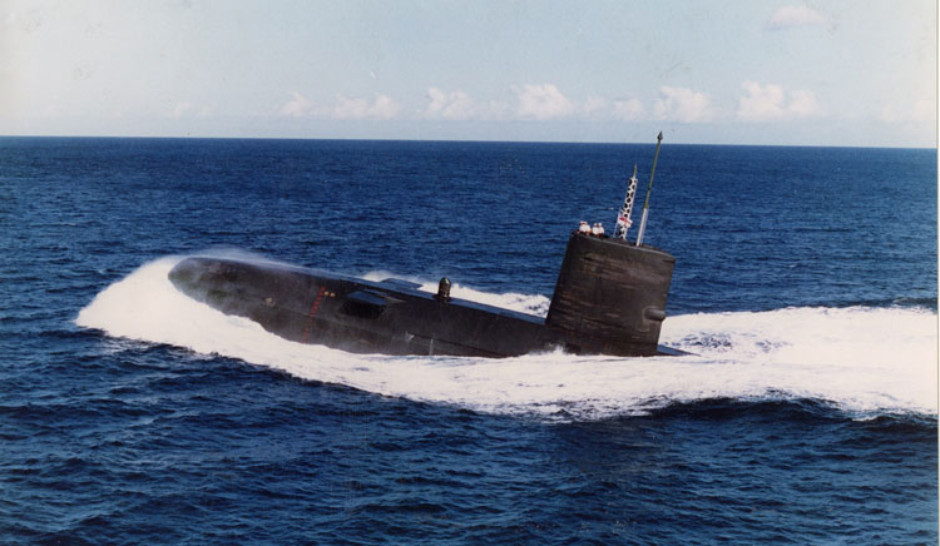
The Churchill Class were capable of semi-planing when running at high speed on the surface. HMS Courageous is seen here.
Lost opportunity
The most potent warship in the Argentinian Navy was the aircraft carrier ARA Veinticinco de Mayo (V-2) whose A-4 Skyhawk fighter-bombers posed the greatest threat to the Taskforce. The British hoped to sink her. On 23rd April the Swiftsure Class submarine HMS Splendid (S106), commanded by Cdr. Roger Lane-Nott, had a clear shot. Yet delays in receiving permission to engage from UK resulted in the opportunity being lost. HMS Splendid went on to conduct daring surveillance missions close to the Argentinian mainland, providing the taskforce with early warning and detailed composition reports of incoming airstrikes.
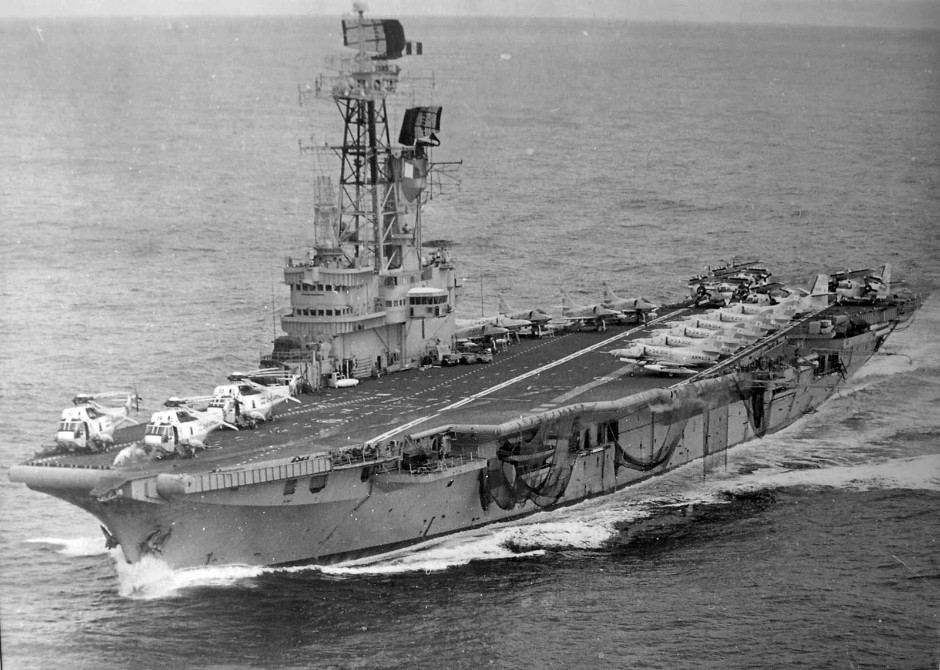
ARA Veinticinco de Mayo (V-2) with 11 A-4 Skyhawk jets on deck. She also carried Tracker ASW aircraft (3 visible on aft deck) and Sea King ASW helicopters (3 at bow). At this time she could not launch the Exocet armed Super-Etendard jets.
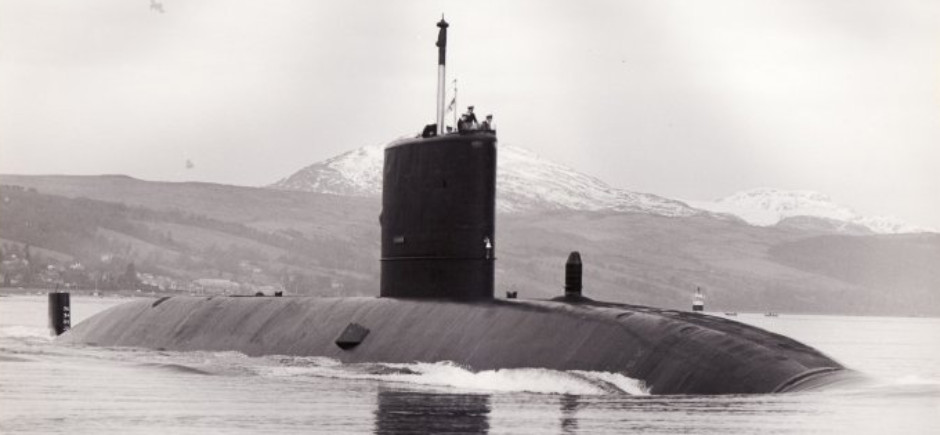
HMS Splendid
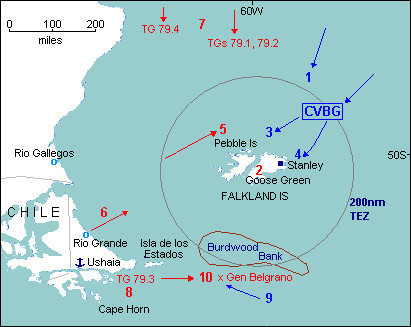 Argentinian plan
Argentinian plan
In late April the British taskforce had been located north-east of the Falklands. The Argentinian plan was a simple pincer movement with the main attack delivered by the aircraft carrier (Task Group 79.1) from the north-west. Another Task Group, 79.2, with three Exocet armed corvettes was also positions in support north of the islands.
The lower arm of the pincer was Task Group 72.3 led by the ARA Admiral Belgrano, together with two destroyers and a tanker. The attack would have come on the 1st May.
Map from www.naval-history.net
Attack
2nd May 1982, 1513hr local time: Commander Wrenford-Brown of HMS Conqueror writes in the logbook:
In position 55 23.1S 61 21.0W. I am on the port quarter of TG 79.3 and my target, the Cruiser G BELGRANO, is on the left wing. My intention is to close to a position such that I can fire a salvo of 3 x Mk 8 Mod 4’s from 1800 yards on a Torpedo Track Angle of 100° and a zero gyro angle. I shall then evade to the SE leaving the datum between me and the destroyers for as long as possible to assist my escape.
Wrenford-Brown had selected the unguided Mk.8 Mod 4 torpedo over the more advanced Mk.24 Tigerfish. The Mk.8 was a pure anti-surface weapon and had advantages of reliability and a larger warhead. The wire-guided Mk.24 was an advanced dual-purpose weapon capable of attacking deep-diving enemy submarines. It was also much longer ranged (39 nm at low speed or 7 nm at 35 knots). Although it had been in development for many years it was a less mature system and suffered reliability concerns, particularly wire breaks. However, Wrenford-Brown divided his torpedo tubes in half with three of each type loaded. This meant that his Mk.24s offered a contingency if he had to take a longer ranged shot.

1551hr local time: Conqueror comes up to periscope depth sights the Belgrano in range, moving at 11 kts. Wrenford-Brown orders torpedo tubes 1, 2 and 6 (the three with Mk.8s) to standby to fire.br>
1554hr local time: final periscope check.
1557hr local time: HMS Conqueror fires three Mk.8 Mod-4s at 3 second intervals and a range of 1400 yards. General Belgrano's position was 55°24′S 61°32′W
The first torpedo missed Belgrano and scraped one of the escorts’ sonar dome. If it had detonated it would have resulted in possible double-kill for Conqueror, the stuff of legends, but also may have given Belgrano’s captain moments warning in which to try to take evasive action, perhaps escaping the attack.
The second Mk.8 hit about 15 meters (50 ft) behind Begrano’s bow near the chain locker for the anchors. This blew off the ship's bow but caused no casualties as this part of the ship was unoccupied.
The last hit Belgrano amidships, exploding in the aft machine room. The damage was catastrophic. Soon the ship was filled with smoke and listing to port. The Argentinean damage control was limited and disadvantaged by electrical failures which affected the water pumps.
1624hrs local time: Belgrano’s captain, Héctor Bonzo, ordered the crew to abandon ship.
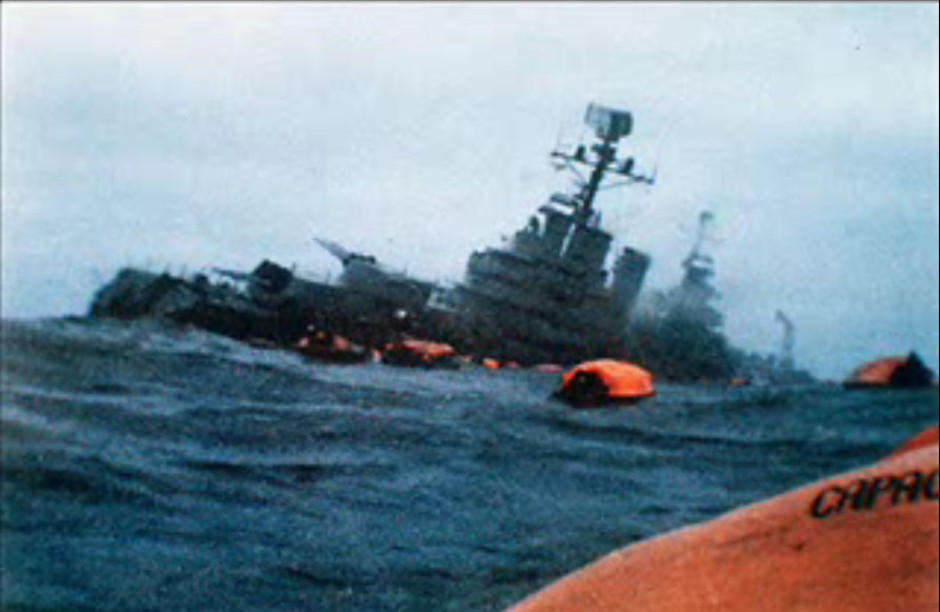
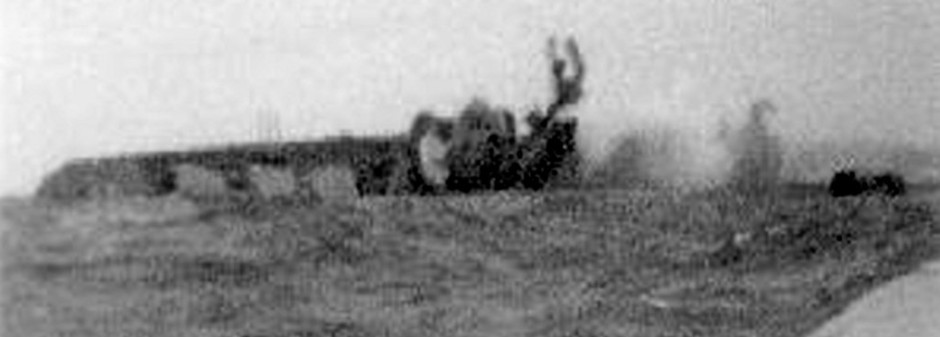
Argentinean losses amounted to 323 men, with 722 survivors being rescued, some after spending nearly 2 days in life rafts in terrible conditions.
With news of the sinking the Argentinean carrier and her escorts retreated to home waters and the surface fleet did not venture out for the remainder of the war. The tactical advantages of the British submarines had dealt a strategic blow.
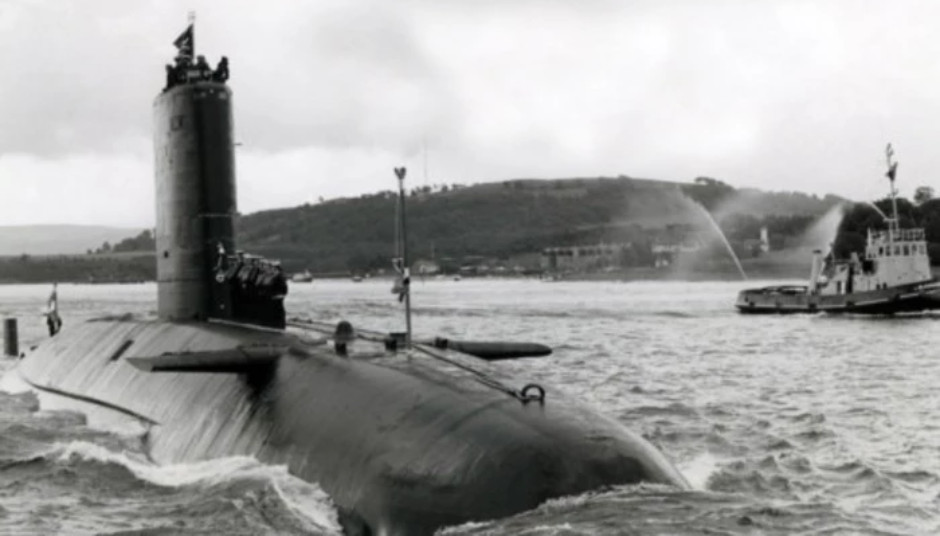
HMS Conqueror returns to Portsmouth, UK. The Jolly Roger (pirate flag) is a RN Submarine Service tradition when returning from a successful mission. It had a bar sown in to represent the sinking of the Belgrano. There was also a dagger representing a special operation.
Some other articles

 HUSKY Class future attack submarine
HUSKY Class future attack submarine

 USS Parche spy sub par-excellence
USS Parche spy sub par-excellence

 Japanese Ko-Hyoteki midget submarine of WW2 - Pearl Harbor attack
Japanese Ko-Hyoteki midget submarine of WW2 - Pearl Harbor attack

 BS-64 Podmoskovye Special Mission (spy) Host Submarine
BS-64 Podmoskovye Special Mission (spy) Host Submarine

 Project 09852 Belgorod Special Mission submarine (spy sub)
Project 09852 Belgorod Special Mission submarine (spy sub)

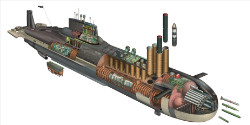 Russian Typhoon Class SSBN
Russian Typhoon Class SSBN




 +
+ 



 Nuclear Missile submarines
Nuclear Missile submarines















 World survey of AIP submarines
World survey of AIP submarines

 Japanese Ha201 Sen-Taka-Sho fast attack submarine of WW2
Japanese Ha201 Sen-Taka-Sho fast attack submarine of WW2

 P.09851 KHABAROVSK and KANYON (Status-6)
P.09851 KHABAROVSK and KANYON (Status-6)

 SIERRA Class SSN
SIERRA Class SSN

 Russian Losharik spy sub
Russian Losharik spy sub

 USS Halibut
USS Halibut

 USS Seawolf (SSN-575)
USS Seawolf (SSN-575)

 British SDV developmemts in 1960s (Dick Tuson)
British SDV developmemts in 1960s (Dick Tuson)

 SubCat SDV
SubCat SDV


 Marex Type-A (A2, A4, A5, Comex Total-Sub-01) SDVs
Marex Type-A (A2, A4, A5, Comex Total-Sub-01) SDVs


